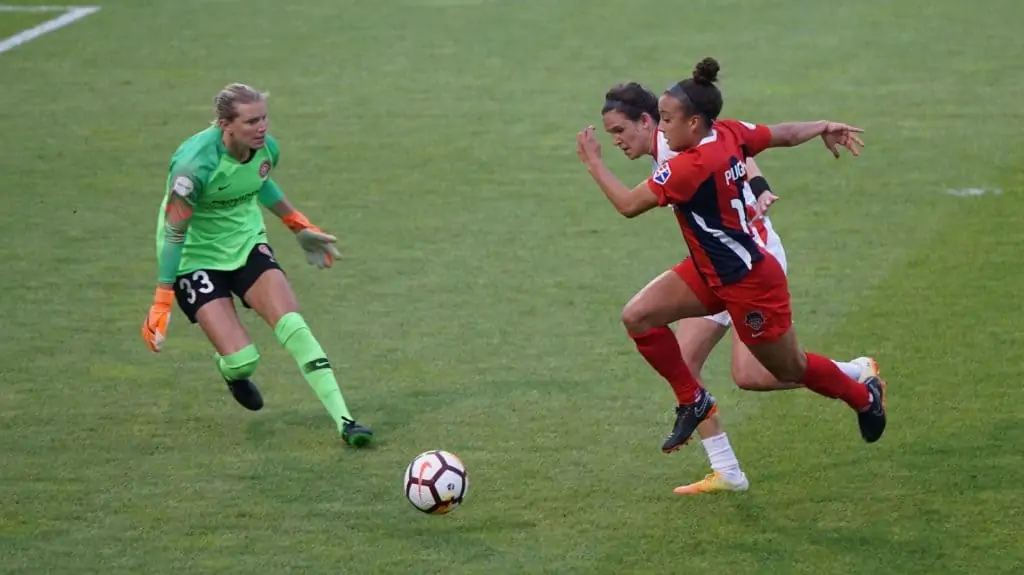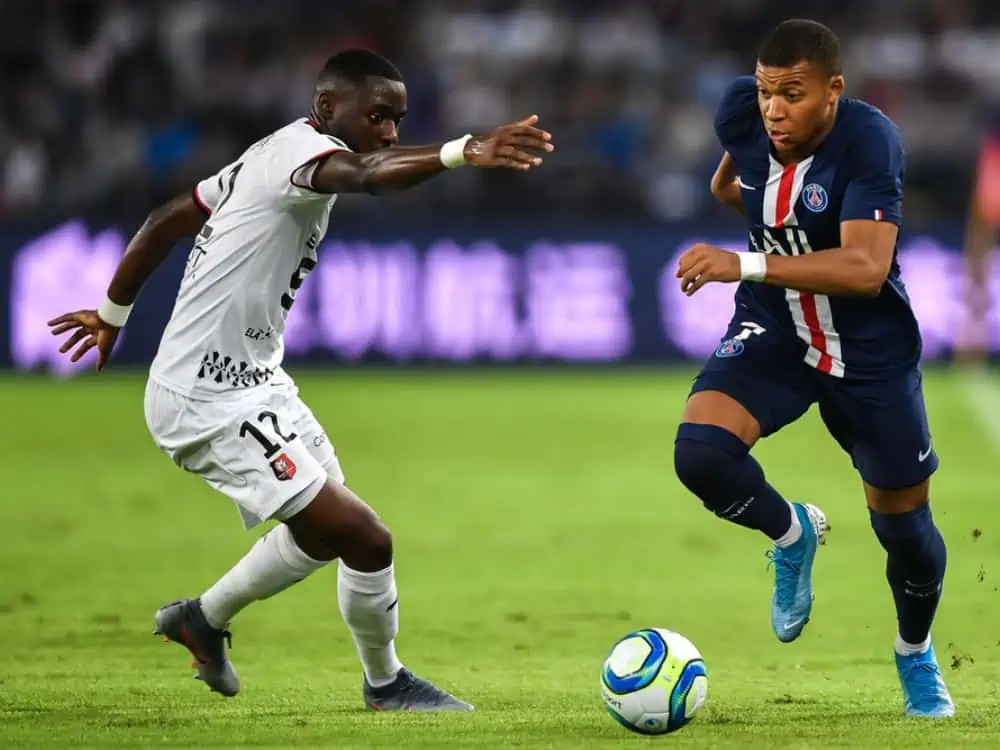Share the post "Where Do You Put Your Strongest Soccer Player? (Solved!)"
Whether listening to professional announcers, general soccer fans, or people who don’t know much about the game, you’ll hear much about the goal-scoring forward.
In soccer, much of the conversation and recognition revolves around forwards, but is that really where the strongest players on the team play?
In reality, every soccer position has components that make it difficult. You should not necessarily put your strongest soccer player as a forward. Instead, you should put them in a position that best suits their strengths while helping the team.
To determine the best position for a strong soccer player, you must narrow down what makes them a strong player, consider their interests, and evaluate based on your team’s style of play.
What is the toughest position in soccer?
There is no soccer position that is more difficult than others. Each position demands different strengths and has different challenges associated with it.
For example, if you take an incredible striker and put them as a goalkeeper, they probably won’t excel. The opposite is often also true.
Every soccer position is tough in its way. Let’s take a look at some of the demands of each position.

Goalkeeper
As the last person standing between the opponent and the goal, the goalkeeper has a crucial job. They can see the entire field and use their hands within their box, but that doesn’t make this position easy.
Here are some of the skills that goalkeeping requires:
- Hand-eye coordination (something a lot of soccer players struggle with).
- A good vertical.
- Explosivity and power for quickly reacting to shots and challenging 1v1 situations.
- A fearless attitude, a willingness to put your body on the line for the team.
- Excellent communication skills to direct and organize defenders.
- Good clearances and long balls.
Central Defender
Central defenders play a crucial role in team defending and begin the attack. They are often the last field player back, with only the goalkeeper as a safety net. Here are the top skills required of a center back:
- Speed to handle opposing forwards.
- Excellent tactical awareness. Must be able to see the field and direct other players.
- Great 1v1 defending skills.
- Strong in the box. Central defenders must be able to clear outcrosses and corner kicks.
- Accurate long passes, both on the ground and in the air.
- Strength to battle with forwards on the opposing team.
Outside Defenders
Don’t let the word “defender” fool you. The modern-day outside back must be able to contribute defensively and offensively, especially for formation variations of the 4-3-3 (like the 4-1-2-3 or 4-2-1-3).
Quality outside backs (and wing players) must be:
- Extremely fit, able to push the width into the attack and recover.
- Most wide defenders are fast, which helps them cover the width of the field.
- Great 1v1 defenders. Outside backs are isolated in many formations and must handle the opposition’s wide forwards or midfielders.
- Footwork is not only for forwards. Outside backs must be able to drive down the line and take on players.
- Since outside backs get into the attack so much, they should be able to deliver great crosses.
Central Midfielders
Center mids are pivotal for the attack and defense. They are crucial for a team’s transition and must contribute on both sides of the ball.
Some of their key strengths include:
- Fast speed of play.
- Well-rounded in all foundational skills (passing, dribbling, trapping, etc).
- Strong in the air to challenge the opposing goalkeeper and defense long balls.
- Fit to run long distances. Central midfielders cover the most ground on average.
- Excellent tactical understanding of the game and vision.
Strikers
Wide forwards have many of the same demands as outside backs, but strikers have a different key role. The best strikers are goal-scoring machines, bringing much more to the table.
Here are the top skills strikers have:
- A hunger for the goal. They’re eager to score and take chances.
- Accurate, powerful shots.
- Great finishing skills; they can finish simple passes to the corner, volleys out of the air, and set pieces.
- Physicality. They may be fast, strong, or both, but strikers must be able to handle the physicality.
- Great ball trapping skills.
- Resilience in handling missed shots. Strikers will shoot far more than they will score.

What position is the most important in soccer?
Every position plays a critical role in the game of soccer. As a team sport, soccer requires the efforts of every player.
If you ask the average person what position they think is the most important, there’s a good chance they’ll say forward/striker.
While you need at least one goal to win, you must be able to thwart the opponent’s attack effectively.
ESPN argues that the goalkeeper is the most important position because they:
- Can see the entire field
- Can single-handedly save you the game
- Has a job with an incredibly small margin of error
Who is the hardest working soccer player?
Every player in every position must work hard to help their team. Despite the importance of every player, midfielders and wings are often seen as the hardest working.
According to the Bleacher Report’s analysis of the 15 hardest-working players in the EPL, 5 were midfielders, and 5 were wings.
Central midfielders, especially the common “box-to-box” midfielder, have to cover a ton of ground. They must quickly transition from attack to defense and vice versa.
They control the center of the pitch and must be focused and always working.
Wings also cover a lot of ground, and often in a sprinting fashion. Wings are tasked with the challenge of pushing high into the attack and whipping crosses. They are often athletic and incredibly hard-working.

Where to play your best soccer players?
Should you put your best player there if a goalkeeper is such an important position? Not necessarily, but you should put your best goalkeeper there.
There is not a one-size-fits-all answer for where to put your best player.
Determine their strengths. Choose a position with demands that align with the player’s strength and can expose the opponent.
Different skills strong soccer players may have
Once you’ve defined what makes the player strong, you can best find a position that illuminates their abilities.
Here are some qualities that may make a player stand out:
- Crafty dribbling skills, the ability to beat players 1v1.
- Strong defensive knowledge and skills.
- Tactical understanding and vision.
- Quick decision-making, can read the game fast.
- Passing accuracy.
- Speed and agility.
- Shooting accuracy or power.
- Hand-eye coordination (goalkeeping)
Based on the areas the player excels in, you should match them with a position that allows them to have the biggest impact on the game.
Here are some examples of where to put players based on their skill set.
Skill Set 1
- Skillset: Fast, great at dribbling, and solid 1v1 defender. However, they are not the best at shooting.
- Position: outside back, wing-back, or wide mid, depending on your formation.
Skill Set 2
- Skillset: A well-rounded player that nails all of the fundamentals. Above average in all core skills (passing, dribbling, trapping, shooting, defending) but lacks one stand-out quality.
- Position: center mid, attacking, or defensive.
Skill Set 3
- Skillset: Great hand-eye coordination, aggressive mentality, and explosive player may lack foot skills or fitness.
- Position: Goalkeeper
Skill Set 4
- Skillset: Powerful, accurate shot. Always hunting for the goal and willing to fail, but may not be the fittest or best at defending.
- Position: Striker or attacking central midfielder
Skill Set 5
- Skillset: Great 1v1 defender with excellent composure that may not be a fantastic dribbler or shooter.
- Position: Central defender or defensive midfielder
Where does the best player want to play?
Coaches often identify a strong player and become determined to play them in a certain position. The player’s strengths could be a perfect match for a position in your formation, but if the player hates that position, it probably won’t go over well.
At the highest levels, players may not get a say in where they play, but for developing players, it is important to consider their interests.
If you want your best player to perform their best and love the game, ask them where they like to play.
Great soccer players play all over the field. Where you put your strongest players should depend on their strengths, weaknesses, and interests and your team dynamic.
Share the post "Where Do You Put Your Strongest Soccer Player? (Solved!)"
Joel is a seasoned soccer journalist and analyst with many years of experience in the field. Joel specializes in game analysis, player profiles, transfer news, and has a keen eye for the tactical nuances of the game. He played at various levels in the game and coached teams - he is happy to share his insight with you.



